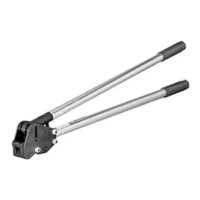DSR-118 MANUAL SEALER
Part No. 306200
GENERAL SAFETY CONSIDERATIONS
1. EYE INJURY HAZARD.
Failure to wear safety glasses with side shields
can result in severe eye injury or blindness.
Always wear safety glasses with side shields
which conform to ANSI Standard Z87.1 or EN 166.
2. FALL HAZARD.
Maintaining improper footing and/or balance
when operating the tool can cause you to fall. Do
not use the tool when you are in an awkward
position.
3. CUT HAZARD.
Handling strap or sharp parts could result in cut
hands or fingers. Wear protective gloves.
4. TRAINING.
This tool must not be used by persons not
properly trained in its use. Be certain that you
receive proper training from your employer. If
you have any questions contact your Acme
Representative.
5. TOOL CARE.
Take good care of the tool. Inspect and clean it
daily, lubricate it weekly. Replace any worn or
broken parts.
6. WORK AREA.
Keep work areas uncluttered and well lighted.
7. TENSIONING STRAP.
When tensioning strap use proper tensioner for
specific strap sizes. Read the tensioner's
operation and safety manual.
Several combinations of strap, seals and tools can be
used with this sealer. Use the correct Acme products
for your application. If you need help contact your
Acme Representative.
SAFETY PROCEDURES FOR TOOL
OPERATION
1. Before using this sealer, read all the instructions
in this Operation, Parts and Safety Manual.
2. Always lift and carry the tool by the tool handle
knob. Lifting the tool at any other point may
expose the hand to a "pinch point."
3. Make sure the sealer jaws are placed directly on
the seal.
4. While sealing, position yourself to one side of the
tensioned strap.
5. This tool is a double reverse notch sealer. A
properly notched seal will appear as shown in the
illustration. If the notched seal does not appear
as shown, inspect the tool for worn and/or
damaged parts. Replace tool parts as needed.
Do not ship any loads secured with improperly
notched seals.
Seal must be
properly
notched.
CUTTING TENSIONED STRAP
FLYING STRAP HAZARD. Using claw hammers,
crowbars, chisels, axes or similar tools will cause
tensioned strap to fly apart with hazardous force.
Use only cutters designed for cutting strap. Read the
instructions in the cutters manual for proper
procedure in cutting strap. Before using any Acme
product read its operation and safety manual.
SPECIFICATIONS
For use with 3/4" High Tensile steel strapping .022" to
.031" thick.
OPERATING INSTRUCTIONS
1. Fully open the sealer handles and center the
open jaws on the seal.
© Copyright 2008, Acme 512157 Rev. 11/2008
1-877-862-6699
www.traditionaltool.com

